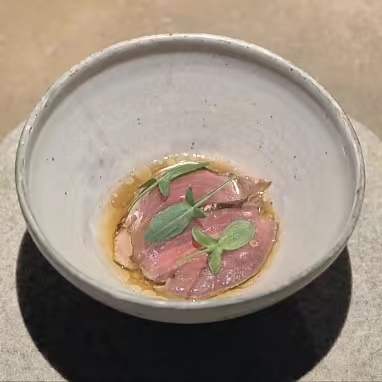Opened in 2018 here in the alleys of Taipei by Hokkaido-born Chef Ryogo Tahara, French cuisine restaurant logy is a romantic spin-off from Hiroyasu Kawate’s two-star Michelin restaurant Florilège in Tokyo. With an innate sense of natural ingredients and a persistent search for unique Taiwanese flavours, Chef Tahara cooks in an unpretentious way, but his insistence on mastering people’s understanding for good food is self-evident. Within a short span of three years, logy has scooped two Michelin stars and has been ranked Top One among Asia’s 50 Best Restaurants in Taiwan. This time trying logy’s spring menu was a surprisingly great experience, as I could detect more traces of local elements when its creator incorporates multifaceted techniques from Japan, Italy and France.
Like a smooth ballad, the seasonal dishes crafted by Chef Tahara were infused with airiness and delicacy. His globetrotting experience and attention to detail allow him to capture the key to unlockingirresistible flavour portfolio. The sweet-and-sour-themed spring menu proudly presents Japanese-inspired French dishes, offering refined elegance with Taiwanese flair.
The meal started with an amuse bouche of shrimp with mango & passion fruit puree. Visually it was a round caramelized onion meringue that’s meltingly soft, supported by savoury fermented radish powder and a sweet and sour blend of shrimp and mango & passion fruit puree underneath. Though the fermented radish powder could have played a greater part, umami still was the main tone to kick start the meal.

Amuse Bouche
Next was fresh Hokkaido scallop. Paired with a sauce made from Aomori apple juice, the dish was tender and flavourful with diced green apple, French caviar and topped off with some fuki (also known as butterbur, a stalk vegetable used in Japanese cuisine). One thing specialabout this dish was the ingenious use of lavender oil – fragrant early-summer lavender flourishing up on the hills of Hokkaido popped up in my mind. Taiwanese people like to eat bitter gourd in summer for its cooling effect – probably why the slightly bitter fuki was used here.
The amadai fish was fried to perfect crunchiness and readiness with a tender and fatty center, and served with crisp, slightly acid Belgian white asparagus to strike a balanced mouthfeel. Apart from clam juice, white wine and butter, the sauce also featured Kyoto white miso for a whiff of thickness and Japanese touch. The ability to balance different ingredients is a common trait among talented chefs. For this dish, Tahara specially brought in milder Japanese yellow mustard as an optional dip to add acidity. Personally I prefer the fish without the dip.

Scallop

Amadai
A signature interpretation of Taiwanese flavours by Chef Tahara, the Chawamushi was topped with crab meat and cooked with beef broth and dried squid, accompanied with a dollop of Angelica ice cream for a medicinal touch. The juxtaposition of temperatures and textures made for an unforgettable dish that was pure, vital delight. Eating Tahara’s dishes sometimes makes you think, “How can they not taste good?” His talent for creating and combining new culinary possibilities is evident.
Exuberant of colourful and floral pleasures, the tart dish had a base of sweet peas, onion, bacon and green asparagus, with layers of roasted brussels sprout, rose petal, pansy, oxali and mustardy nasturtium, and shaved 36-month-aged parmesan on top. The dish was similar to a French quiche, with a warm bottom layer, except the sauce was replaced with the lighter hollandaise. If I must nitpick, I prefer raw sweet peas to cooked ones, since the latter is a result of compromise made with the market. The pairing wine was a Gewürztraminer white wine from South Island, New Zealand, complementing the dish with its heady aromatics and balanced acidity.

Chawamushi

Tart
Moving on to Tahara’s signature dish, the bonito with rice featured straw-seared Hualien bonito and creamy risotto made with Taiwanese sticky rice, hazelnuts, mushroom stock and coffee oil. Bonito is a returning fish species that travels up north on the Pacific coast side of Japan with the nutrient-rich Kuroshio Current in early summer. Young bonitos at this point are typically made into seared sashimi at restaurants in Japan, when the aroma of smoke from burning straws brings out the umami flavour in bonito. The east coast of Taiwan is also home to schools of quality bonito with delicate meat and logy’s handling of the smoking process was accurate. The dish is reflective of Tahara’s Italian experience and Japanese roots: the local sticky rice was flavoured with higher acidity and enriched by perfectly smoked bonito, exotic coffee oil and some nutty notes. You could say it’s a Japanese-inspired Italian cuisine or vice versa.

Bonito
Dutch veal ribeye was wrapped in caul fat and coupled with two kinds of sauce, one made of beef knee sauce, saffron and coriander seeds, the other being creamy beef bone marrow sauce. It was served with cardamom puree, spring bamboo shoots, parsley oil bread crumb, and Japanese kinome leaves. Eating bamboo shoots is also common in Kyoto, while Chef Tahara prefers Taiwanese spring bamboo shoots as they are sweeter and less astringent. The bamboo shoots served here were handled with excellent heat control. The veal, bone marrow, and bread crumb were a deconstructed version of Veal Milanese. It seems that Italian cuisine has had a greater impact on Chef Tahara than French cuisine. Personally I would choose more intense meat dishes over veal, but of course this dish was outstanding both in terms of craftsmanship and quality of ingredients.

Veal
Decorated with golden berry jam, calendula petals and oriental beauty jelly, seasonal loquat was soaked in a cold soup made from IPA beer and bay leaves, boasting a pure and elegant taste. Serving this one at a Japanese restaurant would not be inharmonious at all. Another dessert – Sakura – used salted cherry blossom ice cream made with creamy Panna Cotta and mascarpone cheese. Full of Italian vibe! It was the first time I tried a cherry blossom pastry with a filling of red bean and salted cherry blossoms. A quite strong blend of sour and salty taste but not overwhelming, much lighter than I expected. The meal ended with a distinctly Taiwanese dessert of aiyu jelly, similar to the role of matcha in Japanese food, a refreshing yet satisfying final touch.

Loquat
“Refreshed” was the word when I finished my meal. Grew up in a rural area of Hokkaido with only 2,000 residents, Tahara developed strong interest in cooking and natural ingredients. At the age of 19, he entered a culinary school and later worked in an Italian restaurant in Sapporo. Many senior chefs there went to Italy to pursue further studies, so Tahara moved to Italy to hone his skills as well. Chasing after dreams and aspirations in life is a universal thing, regardless of who you are and where you are from. Japanese chefs are normally welcomed in French and Italian kitchens, because if diners see a Japanese chef in the kitchen, there is implicit reassurance that their meal wouldn’t go wrong.
In Italy, Chef Tahara set off on a three-and-a-half-year journey working at Michelin-starred restaurants including La Ciau del Tornavento and La Torre del Saracino. In 2015, he returned to Japan to join Florilège and became Hiroyasu Kawate’s right-hand man. Inheriting bold spirits and solid skills, Tahara went to head up logy with an aim to honour the terroir of Taiwan and the flavours of Asia.
Logy’s menu is not long, but it’s packed with brilliant dishes that do not sit heavy in your stomach. It’s the kind of perfect status when you finish a meal, not the kind when you have to squeeze in 20-some courses at some three-starred restaurants. Besides, Michelin Star ratings are determined based on a range of strict criteria, of which the length of menu is not particularly high on the chart.

Jocelyn华姐(left)/Chef Tahara(right)
Much like the suffix – logy which conjures ideas of study and theory, Chef Tahara is also a keen researcher of culinary arts. Over the past three years, he has travelled around Taiwan many times to dig into local ingredients, and it is through his dishes that he expresses more confidence in using local elements and feels more comfortable with being himself.
For Tahara, having earned two Michelin stars does not qualify for an excuse to slow down. At 39, he still holds himself to very high standards and makes sure he continues to explore more Taiwanese ingredients and fermented foods, delving into the philosophy of balance witha non-stop craving for knowledge and learning.
-END-











